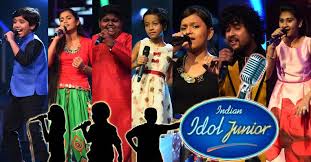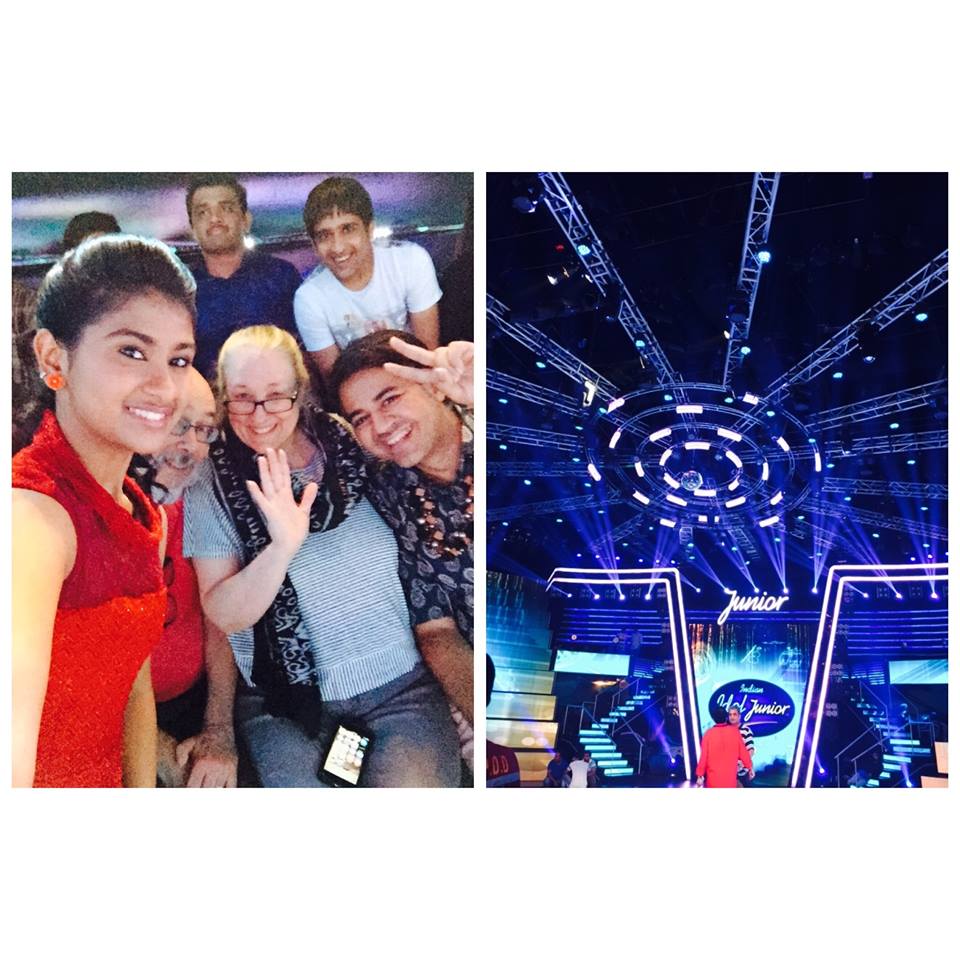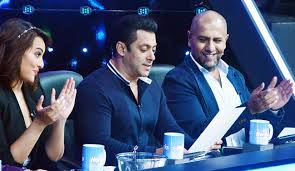Behind the Scenes at Indian Idol Junior
/I have been running a series of blog posts sharing some of the experiences I had during a five week tour of India this summer, thanks to the hospitality of Parmesh Shahani and the good folks at Godrej India Culture Lab. Since I have much to share, I have been breaking up this travel narrative with other segments, but I wanted to pick up again today with a segment describing what we saw when we were able to attend a taping of Indian Idol Junior. The following is adopted from my travel diary.
Today’s main event was a trip to Studio City, which was nearby, for a taping of Indian Idol Junior. We drove down meandering roads through Studio City, where there are a number of smaller studios, some of whom seemed to be shooting things on their front lawns, all involved in film and television production. My favorite because of the cultural incongruity was Swastick Studios, which used the local variant on the Swastika as its brand logo. (It is a traditional good luck sign in Hindu and other local religions, which the Indians have refused to cede to its 20th century associations.)
We pass through multiple levels of security and some degree of confusion before we find our way to the studio where they are shooting Indian Idol. We are the guests of the program’s creative director, who is a family friend of the woman who runs the media program at Sophia. We are immediately ushered upon arrival onto the sound stage and given a seat of honor.
The studio space is surprisingly small, even compared to its American counterparts. Cynthia and I have never gone to an American Idol taping but we have been to a Survivor finale and to a taping of So You Think You Can Dance. A key difference is that both are taped lived before a very active studio audience.
Here, they are taping two episodes back to back on a Sunday which will air across the coming week: a result show is taped in the morning and aired last night; we are there for the taping of the performance competition (the top ten) which will air the following Saturday night. Parmesh says this is required to accommodate the judges, one of whom Sonakshi Sinha is a Bollywood glamour queen, second or third generation superstar. So, we are directly in front of the performance space and we have a good view of the area where the contestants sit when they are waiting to go on, of the judge’s table, and an area where the parents of the contestants sit. And above us, there is a small ring of enthusiastic fans who cheer wildly during each segment. We seem to be sitting in an area for friends and family of the producers.
Before the production starts, we are able to watch the contestants mill about, getting last minute advice or touch ups from their parents. One of the contestants, who we will call Red Dress, was working the crowd and we posed for a selfie with her. She’s also playing up to the judges, bringing around a local sweet from her region and passing it out to the judges and the announcers, even the production grips, on the pretext that it is her birthday. As we observe her throughout the performance, it is clear that she is the one to beat in the competition – she’s got incredible vocal skills – but she also knows it, and she’s a bit of a prima donna, who tends to boss the other children around. She’s apparently been adopted by a number of Bollywood stars who tweet out their support around each episode.
The children are dressed in a wide array of clothes, some very westernized, some traditional, all brightly colored to pop on the camera. The songs they sing are Bollywood standards, and unless I am fooled by the less familiar patterns of these songs, they are much more challenging and vocally complex than the songs typically sung on American Idol. And we are dealing with contestants who range in age between 9 and 14-15. The stress on these contestants must be intense (We saw the tail end of last night’s result show when we got back to our quarters, and the contestant voted off weeped with enormous intensity.)
The conventions of the show are universal, so even without knowing a word of Hindi, we can follow more or less what goes on. But because this is taped, not live, there’s a lot of set up and primping between numbers. It’s also got a different rhythm with much more time devoted to the male and female hosts. The male host with fluffed up hair is the Indian equivalent of a baggy pants comic who performs broadly; his female counterpart – in a lime colored pants suit and high heels – also plays broadly but is a more reactive character. They do a lot of prop humor setting up each segment.
Then, the singer’s perform, always in one take, and near the end, the cameraman do a sweeping pan around them, pushing the camera almost into their face, and then, the judges judge.
The judges are speaking Hinglish – a mix of English and Hindi. Parmesh says that these elite Indians are used to speaking in English and their Hindi is not especially strong. In between takes, the judges are always on their cell phones, texting, but they are also getting made-up by their personal staff and they are brought food. We watch one of the judges plow through a meal of chicken and salad in about two minutes between takes, as if this was the only food he was going to get. We were amused that the judges have cups displaying their sponsor, Horlicks, a hot milk-based drink, in front of them, but we saw a staffer pour Coke Zero into each cup between takes.
Then, the contestant offers their pitch to the public – which moves between Hindi and whatever local language they speak. Indian Idol taps intense regional pride and rivalries, often with massive rallies and voting drives in local areas to insure that support gets directed towards contestants who are the source of enormous pride for parts of the country that are rarely represented on television.
There’s often also a segment involving one of the parents, full of stories of sacrifice and determination. The parents mostly come from working class backgrounds, often from rural areas, and so they may speak only their local languages, but they are coached to be able to speak in Hindi or English for the national television audience.
Finally, there may be some sketch involving the contestants and the judges which are designed to further define their characters. So, one of the contestants came out in a traditional tunic-based outfit, which the announcer rips away to reveal rocker clothes underneath, for what turned out to be a show-stopping, defining performance (perhaps the best of the night coming from a young man who had been in the bottom three in last week’s results). Another young boy pulls a lizard (or what we hope was a toy lizard) out of his pocket and sticks it into the hand of the female host who shrieks on cue and drops it on the ground. There’s a dance-off between the Bollywood Glamour Queen and the Female Announcer, both in high heels. A village boy shares that he misses playing marbles with his friends, so they bring out a blanket and marvels, and the male announcers and judges play marbles with him. I am not sure what use is going to be made of this material, since everything is running so much longer than an American show would, and Indian Television is if anything heavier on commercials than American broadcast television is. Taping this episode took a full four hours.
We all have our favorites. Despite her bossiness, I can’t help but root for Red Dress, just because she really has amazing vocal chops, and for the boy who transformed into a rocker, for much the same. But there is the “Drama Mama,” the youngest contestant, who dances – not especially well, but its more movement than most of the others; there’s a boy who wears a turban and traditional clothes; and a range of others. Right now, it’s 3 boys and 7 girls, so we are betting one of the girls goes home this week. She seemed flatter than the others; looked really dejected afterwards, and while the judges were kind, they were much less effusive than they had been with the other contestants. Our sense was she knew it was her turn to go, but we will have to wait till next Sunday to see the results.
We did watch the episode when it aired the following weekend. It was fascinating to see what made it onto the air. Having gotten rid of liveness, the program also got rid of any pretense of “real time.” The footage is tightly, almost abruptly, edited, with only the highlights of the responses aired. This helps to explain why they shot so much more than was aired. In the studio, everything seemed to be much slower than on the American version. On the air, much faster. It has that feel of cutting from highlight to highlight. Aesthetically, it is a very different experience of the program.
Most of the sketches I described ended up on the cutting room floor. They did use the segment of the village boy’s marbles game – which Parmesh did not think they would use because the judges were so bad at marbles, but this becomes the focus of the editing. They did not use what we saw as a more successful segment where the boy sticks a lizard in the hand of the female announcer. I wondered if some of those segments were shot for distribution online.
The soundtrack has also been juiced up – comic noises to prop up the mugging of the announcer, audience noises to amp up the responses of the somewhat meager studio audience, and especially a better sound mix for the performances than we heard in the studio. It’s hard to tell if they worked from the raw tracks or rerecorded the songs, which, of course, has serious implications for a singing competition.
They also had altered the sequence of the performances dramatically with the boy who rips off his traditional clothes and becomes a rocker as the starting point for the program and one of the first performances we saw ending up the broadcast. We’ve always suspected that American Idol structures their live shows based on who did the best job in rehearsal, but here, the actual editing of the content reflects this assumption as well.
If you'd like to read more about Indian Idol, check out this great essay by another of my former MIT students, Aswin Punathambekar, which deals with the local campaigns to support contestants as a kind of civic activity.































